 Is customer experience maturity the priority in your Chief Customer Officer Playbook? In all team sports, maturity is paramount. In rowing or crew, for example, immaturity means lack of synchronization. The lowest common denominator spells the team’s success. In fact, lack of synchronization is at the heart of any sports team’s maturity and success.
Is customer experience maturity the priority in your Chief Customer Officer Playbook? In all team sports, maturity is paramount. In rowing or crew, for example, immaturity means lack of synchronization. The lowest common denominator spells the team’s success. In fact, lack of synchronization is at the heart of any sports team’s maturity and success.
Consider a sports team that STARTS with synchronization emphasis instead of individual heroics. Synchronization sets them up for greater success, especially under tough conditions. This is true in futbol/soccer, hockey, baseball, basketball, volleyball, cricket, lacrosse, rugby, relay racing, and any other team sport. Unsynchronized sports teams are painful to watch. Plenty of movies feature the underprivileged team rising to greatness when they focus on superior synchronization. You’ve likely observed this in your own team sport participation, or local or professional teams you follow.
Businesses, governments, and nonprofits also rely on synchronization as the key to maturity, efficiency, and growth opportunities. Any initiative that lacks synchronization fails to reach its full potential.
Synchronization pays off in winning as well as enjoyment among players (employee experience), fans, and investors.
-
Maturity = reaching your full potential.
3 success factors for reaching your organization’s full potential are:
- Coordinate full potential value
- Be bold THIS year
- Synchronize
CX Maturity Playbook Rule 1: Coordinate Full Potential Value
Value is not just top-line growth. It’s sustainability of growth, strategic advantages, and efficiency. These last 3 value areas are pivotal to reaching your full potential — and maintaining it.
Value is:
- communicated by Marketing and Sales.
- fulfilled by Service Delivery and Logistics and and partners.
- rescued by Service Recovery.
- created primarily by all non-customer-facing groups and suppliers.
Does your Chief Customer Officer Playbook recognize this as your starting point?
If not, you’ve got a lot of untapped value! Ironically, CCOs tend to create a kingdom of underlings, and they get saddled with pressure to generate revenue by making Service a profit center and/or driving repurchase through Customer Success or loyalty programs. That setup makes it nearly impossible to coordinate value communicators, fulfillers, rescuers, and creators!
What’s needed:
- Give credit where it’s due: orchestrate your built-in extended CXM team.
- Educate EVERY work group about their essential role.
- Position your core CX team as brand integrity champions.
- Influence customer-centered strategic plans of every group to convert costs, embolden expansions, and straighten strategies.
- Emphasize lifetime value as everyone’s ultimate goal
CX Maturity Playbook Rule 2: Be Bold THIS Year
When I led companywide CXM, we were in the top 2 CX maturity levels (Align + Embed) within 18 months. You can do this, too! There were plenty of reasons why this was perhaps impossible — yet we achieved this regardless — because we aimed for it from the start.
 If you’re waiting for any reason, rethink that! Delays cost not only money — they hurt your credibility and indispensability. Beware of maturity models that imply a lot of years before any meaningful maturity level. They depict the immature past — NOT what we need to do NOW.
If you’re waiting for any reason, rethink that! Delays cost not only money — they hurt your credibility and indispensability. Beware of maturity models that imply a lot of years before any meaningful maturity level. They depict the immature past — NOT what we need to do NOW.
You get what you aim for, nothing more. Aim for the top!
In team sports, you don’t take a year or so to work on one skill. In golf and tennis, for example, I learned every stance and swing in my first two lessons. In hockey and basketball, teams practice rebounds, dribbling, free throws, and passing every day. Sports beginners take baby steps across the full spectrum of what’s needed in that sport. Then, they stretch themselves to rise to the next levels with a sense of urgency. CX should, too.
Since the 2008 global economic crisis, 15 years of heavy investment occurred in CX tech, CX roles, digitalization, self-service, journey mapping, CX design, etc. Still, only 8% of firms are in mature levels AND 80% of CX managers admit they’re weak in 6 competencies for CXM ROI. In 10 years we’ve seen no noticeable change. (! ? !!! ???)
Why? Eagerness to invest in CX tech before creating a full CX strategy. Ironically, you tie up your CX budget with technology providers and never get to creating a proper CX strategy (see below). Their advice favors their business model.
- Digitalization consumes all your energy, so you postpone all other synchronizations.
- You wait to see what the findings are so you can cherry-pick improvements.
- You want quick wins, so you start with one part of a customer journey for one persona.
- Monitoring real-time VoC with prompt follow-up to Detractors takes all your energy.
- Managers are happy to see they’re in the safe zone: no need to do anything.
- You’re asked to present your quick wins at conferences or you win an award for your quick wins, so you’re now a CX expert.
- Eventually, your executives pressure you to prove financial connections. You can’t. It wasn’t scalable. It did not move the needle for your whole customer base. So, you lose funding, your team gets reassigned to something else, or you leave your job to do it again elsewhere that’s more supportive or consult others to follow what you did.
There is no such thing as one-stop shopping in Experience Management. Personal experience in synchronization is far more important than familiarity with your industry because synchronization skills are universal to all industries. Synchronization is the linchpin: without it, you have a crumbly foundation. With it, every tactic you pursue is much more powerful than otherwise. Figure out your synchronization strategy BEFORE buying technology. What’s needed in YOUR culture for synchronization should dictate technology decisions, not the other way around!
Before making assumptions, ask:
- What evidence can they show you for achieving CX maturity when they were in the hot seat you’re in?
- How did they drive customer-centered cultural transformation?
- How did they implement Rule 1?
Be bold THIS year! YOU can make great progress in the top levels of this maturity model NOW. This is true if you’re starting for the first time, or revising a long-standing CX strategy. Plan THIS year to implement something in the Operationalize, Align, and Embed levels — in tandem. Do not delay!
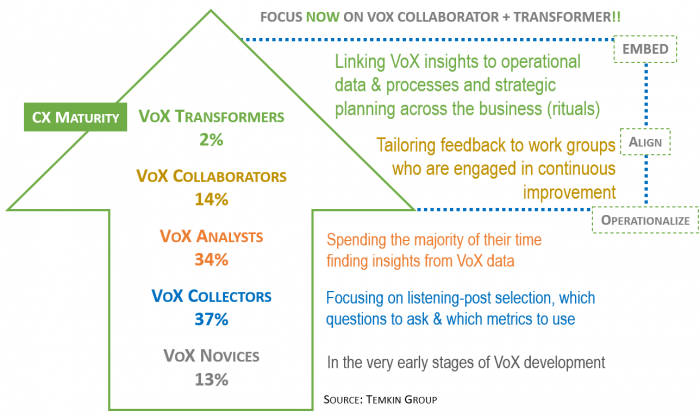
CX Maturity Playbook Rule 3: Synchronize
Maturity models with columns or grids are misleading. They violate Rule 1 (above). Silos are CX kryptonite.
A flowing series of building blocks is a more accurate model of mature customer experience management.
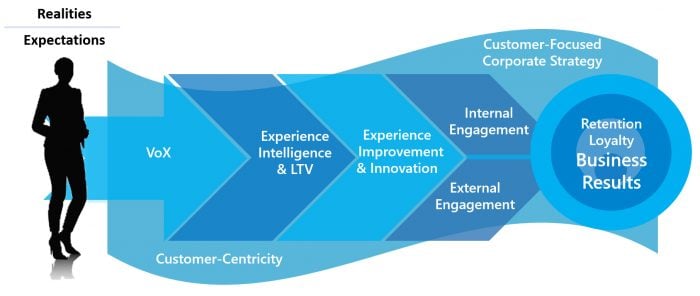
- Everything in CX is helped or hindered to the degree that strategy and culture are in sync with customer priorities. Provide compelling customer insights (patterns) to inspire your Senior Leadership Team’s strategy and culture decisions.
- All improvements and efficiency efforts across your enterprise should be informed by customer insights and lifetime value.
- All designs for growth, including business models and mergers, and new markets and products, should be inspired by customer insights and lifetime value.
- Internal engagement should be at least as intense as external engagement.
- When you follow this model, automatic outcomes are higher retention, loyalty, and business results.
-
Customer experience maturity = 1-to-1 ratio for customer realities versus expectations.
True CX strategy reflects this entire flowing series of building blocks.
This way, you’ll reduce costs significantly in touchpoint management: Customer Service, Customer Success, Loyalty programs, etc.
Ironically over the past 20 years, common practices reverse this, with primary emphasis on touchpoints, and minimal synchronization of the building blocks.
Why? Treating programs as so-called strategy.
Mature customer experience is not:
- Service Excellence: most Service inquiries happen after customer experience failed.
- Digitalization: automated processes do not guarantee seamless, issue-free CX.
- Excellent Design: great touchpoints do not compensate for non-customer-centric policies and handoffs among non-customer-facing groups.
- Customer Retention: Sometimes customers want to switch brands but cannot at the moment; sometimes retention incentives and efforts are costly rather than organic.
- Net Promoter Score: Some customers may recommend more than one brand or say they’re inclined to recommend without ever doing so; when customers’ circumstances change, some Promoters today are no longer there tomorrow; most NPS is inflated because of unequal duration and enthusiasm of Detractors and Promoters; most NPS data is inaccurate because of poor statistical significance and poor survey validity.
- B2B Adopting B2C Practices: B2B has many built-in synchronizations such as dedicated sales teams, so comparing specific CX practices is not a good indicator for how well customers’ expectations are met.
- Revenue Growth: shrinkflation, skimpflation, and inflation reduce value to customers while maintaining or increasing your revenue, so these practices are certainly not customer-centric; Fred Reichheld’s first chapter in “The Ultimate Question” is ironically dedicated to bad profits: any fees/offers/pricing/warranties/etc. that mislead, punish, or nickel-and-dime customers; employees and investors expect value increases yearly at least, so of course, partners and customers deserve ongoing value increases to an equal or greater extent. CX Annuities are your answer to conundrums. ALWAYS increase value. Figure it out!
Instead of focusing on programs, such as those listed above, synchronize the end-to-end CXM spectrum in your CX strategy. Start with the basics in every single building block. Emphasize flow. This will reduce dysfunction, silos, and costs. Most importantly, it will boost performance and clout.
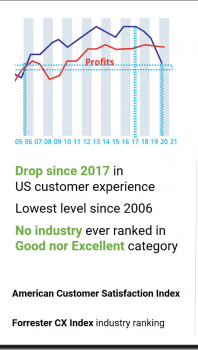 For example, do you believe customers are less important than employees or data/information? Certainly not! Customers pay for employees, budgets, and profits.
For example, do you believe customers are less important than employees or data/information? Certainly not! Customers pay for employees, budgets, and profits.
50 years ago, HR and IT were immature as personnel departments and data processing departments. Thankfully, they stepped up to address ALL the needs of employees, managers, data, and information.
Interestingly, they rely on every single work group to do their part. They don’t baby you with the excuse that maybe you’re too busy to do performance reviews or be responsible for your use of IT resources. They boldly engage everyone in doing their part in HR and IT success.
THIS is what CX needs to do, too: boldly engage everyone in Rule 1.
-
Customer experience strategy = customer-centered business management.
In conclusion, self-assess your customer experience maturity quarterly. Use this 7-point checklist to evaluate your company as a whole, and every business unit. When you reach 4’s and 5’s for all 7 criteria, then your business is customer-centered. High scores in these criteria mean you are minimizing waste and maximizing value.
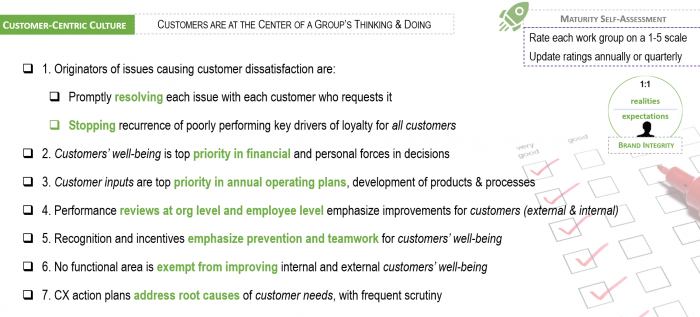
Maturity is a misinterpreted word. When someone or something is mature, it is fully developed, well-balanced, with the ability to toggle to what’s appropriate in every circumstance. Maturity means minimal dysfunction and maximum trust and value. Imagine your company as an elite athlete: every muscle attuned to excel, muscle memory making excellence automatic, unrelenting focus to rise above any adversity, and thrilling accolades and opportunities abound.
I’ve had a front-row seat to observe the customer retention field/industry for the past 30+ years. Are you content for another 30 years to pass with 80% incompetence and 8% top-tier maturity?
So much has changed since 2019 for customers, yet customer experience management practices are still stuck in the 2010s. AI is not the answer to CX maturity. Ironically, every digitalization endeavor requires more human-to-human synchronization within your organization. Every McKinsey report I’ve seen about digitalization success factors underscores this irony. Synchronization of mindsets, motivations, and handoffs across your whole business is vital to value and maturity growth.
Instill urgency among all managers to step up their respective synchronization with one another and most importantly, with customers’ expectations. It’s simple brand integrity: your value proposition was accepted, and customers expect it to be delivered in total, without issues. Aiming for that grows lifetime value. Everyone wins then.
This article is the third in a five-part series:
1. Chief Customer Officer Playbook: Balancing Experience Leadership with Experience Management
2. Chief Customer Officer Strategy: Redundant Playbook or Most Valuable Player?
3. 3 Ironic Success Factors for Your Chief Customer Officer Maturity Playbook
4. Chief Customer Officer Leadership Playbook
5. Chief Customer Officer Prosperity Playbook
Image licensed to ClearAction Continuum by Shutterstock.

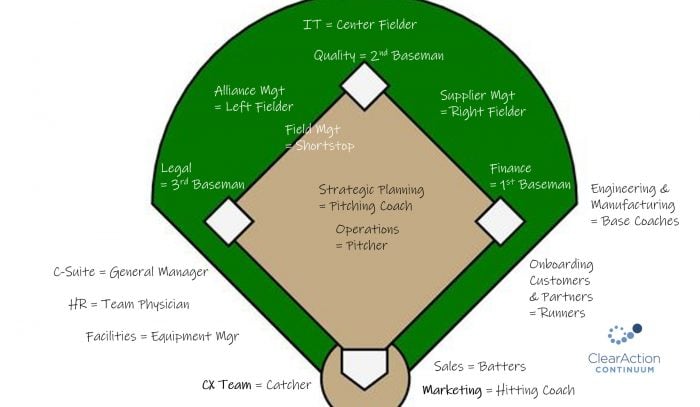



I am really loving these series Lynn, I have read all the 3 rules and when I look at where we have succeeded in CX as an organisation, we have implemented some aspects of success.
I can not wait to put the rest in practice
Looking forward to the next series.
Wonderful, Sonia. It’s so nice to hear you’re doing some of these things and on your way with all of it. Thanks very much for your comment. I’m cheering for every organization worldwide to outpace the 2010s in short order over the next couple of years.